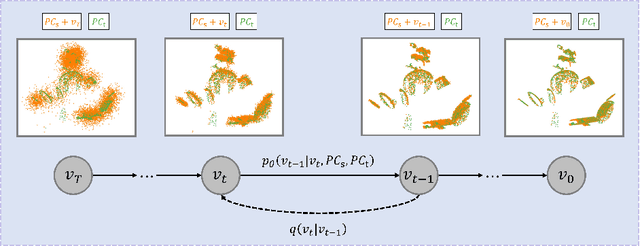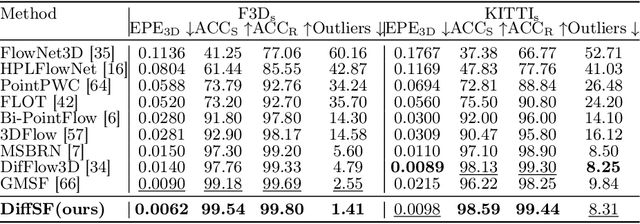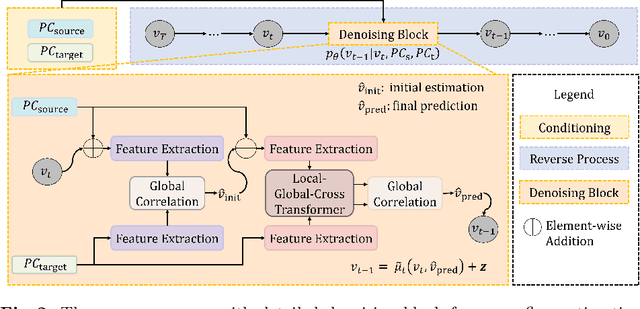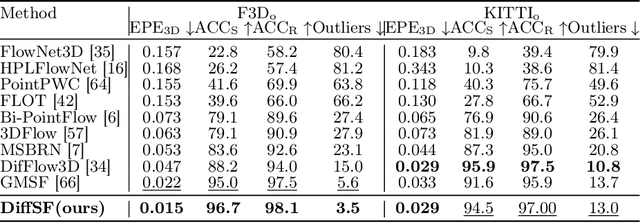Bastian Wandt
Continuous Normalizing Flows for Uncertainty-Aware Human Pose Estimation
May 04, 2025



Abstract:Human Pose Estimation (HPE) is increasingly important for applications like virtual reality and motion analysis, yet current methods struggle with balancing accuracy, computational efficiency, and reliable uncertainty quantification (UQ). Traditional regression-based methods assume fixed distributions, which might lead to poor UQ. Heatmap-based methods effectively model the output distribution using likelihood heatmaps, however, they demand significant resources. To address this, we propose Continuous Flow Residual Estimation (CFRE), an integration of Continuous Normalizing Flows (CNFs) into regression-based models, which allows for dynamic distribution adaptation. Through extensive experiments, we show that CFRE leads to better accuracy and uncertainty quantification with retained computational efficiency on both 2D and 3D human pose estimation tasks.
Utilizing Uncertainty in 2D Pose Detectors for Probabilistic 3D Human Mesh Recovery
Nov 25, 2024Abstract:Monocular 3D human pose and shape estimation is an inherently ill-posed problem due to depth ambiguities, occlusions, and truncations. Recent probabilistic approaches learn a distribution over plausible 3D human meshes by maximizing the likelihood of the ground-truth pose given an image. We show that this objective function alone is not sufficient to best capture the full distributions. Instead, we propose to additionally supervise the learned distributions by minimizing the distance to distributions encoded in heatmaps of a 2D pose detector. Moreover, we reveal that current methods often generate incorrect hypotheses for invisible joints which is not detected by the evaluation protocols. We demonstrate that person segmentation masks can be utilized during training to significantly decrease the number of invalid samples and introduce two metrics to evaluate it. Our normalizing flow-based approach predicts plausible 3D human mesh hypotheses that are consistent with the image evidence while maintaining high diversity for ambiguous body parts. Experiments on 3DPW and EMDB show that we outperform other state-of-the-art probabilistic methods. Code is available for research purposes at https://github.com/twehrbein/humr.
Optimal-State Dynamics Estimation for Physics-based Human Motion Capture from Videos
Oct 10, 2024



Abstract:Human motion capture from monocular videos has made significant progress in recent years. However, modern approaches often produce temporal artifacts, e.g. in form of jittery motion and struggle to achieve smooth and physically plausible motions. Explicitly integrating physics, in form of internal forces and exterior torques, helps alleviating these artifacts. Current state-of-the-art approaches make use of an automatic PD controller to predict torques and reaction forces in order to re-simulate the input kinematics, i.e. the joint angles of a predefined skeleton. However, due to imperfect physical models, these methods often require simplifying assumptions and extensive preprocessing of the input kinematics to achieve good performance. To this end, we propose a novel method to selectively incorporate the physics models with the kinematics observations in an online setting, inspired by a neural Kalman-filtering approach. We develop a control loop as a meta-PD controller to predict internal joint torques and external reaction forces, followed by a physics-based motion simulation. A recurrent neural network is introduced to realize a Kalman filter that attentively balances the kinematics input and simulated motion, resulting in an optimal-state dynamics prediction. We show that this filtering step is crucial to provide an online supervision that helps balancing the shortcoming of the respective input motions, thus being important for not only capturing accurate global motion trajectories but also producing physically plausible human poses. The proposed approach excels in the physics-based human pose estimation task and demonstrates the physical plausibility of the predictive dynamics, compared to state of the art. The code is available on https://github.com/cuongle1206/OSDCap
Temporally-consistent 3D Reconstruction of Birds
Aug 24, 2024Abstract:This paper deals with 3D reconstruction of seabirds which recently came into focus of environmental scientists as valuable bio-indicators for environmental change. Such 3D information is beneficial for analyzing the bird's behavior and physiological shape, for example by tracking motion, shape, and appearance changes. From a computer vision perspective birds are especially challenging due to their rapid and oftentimes non-rigid motions. We propose an approach to reconstruct the 3D pose and shape from monocular videos of a specific breed of seabird - the common murre. Our approach comprises a full pipeline of detection, tracking, segmentation, and temporally consistent 3D reconstruction. Additionally, we propose a temporal loss that extends current single-image 3D bird pose estimators to the temporal domain. Moreover, we provide a real-world dataset of 10000 frames of video observations on average capture nine birds simultaneously, comprising a large variety of motions and interactions, including a smaller test set with bird-specific keypoint labels. Using our temporal optimization, we achieve state-of-the-art performance for the challenging sequences in our dataset.
Representing Animatable Avatar via Factorized Neural Fields
Jun 02, 2024Abstract:For reconstructing high-fidelity human 3D models from monocular videos, it is crucial to maintain consistent large-scale body shapes along with finely matched subtle wrinkles. This paper explores the observation that the per-frame rendering results can be factorized into a pose-independent component and a corresponding pose-dependent equivalent to facilitate frame consistency. Pose adaptive textures can be further improved by restricting frequency bands of these two components. In detail, pose-independent outputs are expected to be low-frequency, while highfrequency information is linked to pose-dependent factors. We achieve a coherent preservation of both coarse body contours across the entire input video and finegrained texture features that are time variant with a dual-branch network with distinct frequency components. The first branch takes coordinates in canonical space as input, while the second branch additionally considers features outputted by the first branch and pose information of each frame. Our network integrates the information predicted by both branches and utilizes volume rendering to generate photo-realistic 3D human images. Through experiments, we demonstrate that our network surpasses the neural radiance fields (NeRF) based state-of-the-art methods in preserving high-frequency details and ensuring consistent body contours.
CasCalib: Cascaded Calibration for Motion Capture from Sparse Unsynchronized Cameras
May 10, 2024



Abstract:It is now possible to estimate 3D human pose from monocular images with off-the-shelf 3D pose estimators. However, many practical applications require fine-grained absolute pose information for which multi-view cues and camera calibration are necessary. Such multi-view recordings are laborious because they require manual calibration, and are expensive when using dedicated hardware. Our goal is full automation, which includes temporal synchronization, as well as intrinsic and extrinsic camera calibration. This is done by using persons in the scene as the calibration objects. Existing methods either address only synchronization or calibration, assume one of the former as input, or have significant limitations. A common limitation is that they only consider single persons, which eases correspondence finding. We attain this generality by partitioning the high-dimensional time and calibration space into a cascade of subspaces and introduce tailored algorithms to optimize each efficiently and robustly. The outcome is an easy-to-use, flexible, and robust motion capture toolbox that we release to enable scientific applications, which we demonstrate on diverse multi-view benchmarks. Project website: https://github.com/jamestang1998/CasCalib.
DiffSF: Diffusion Models for Scene Flow Estimation
Mar 14, 2024



Abstract:Scene flow estimation is an essential ingredient for a variety of real-world applications, especially for autonomous agents, such as self-driving cars and robots. While recent scene flow estimation approaches achieve a reasonable accuracy, their applicability to real-world systems additionally benefits from a reliability measure. Aiming at improving accuracy while additionally providing an estimate for uncertainty, we propose DiffSF that combines transformer-based scene flow estimation with denoising diffusion models. In the diffusion process, the ground truth scene flow vector field is gradually perturbed by adding Gaussian noise. In the reverse process, starting from randomly sampled Gaussian noise, the scene flow vector field prediction is recovered by conditioning on a source and a target point cloud. We show that the diffusion process greatly increases the robustness of predictions compared to prior approaches resulting in state-of-the-art performance on standard scene flow estimation benchmarks. Moreover, by sampling multiple times with different initial states, the denoising process predicts multiple hypotheses, which enables measuring the output uncertainty, allowing our approach to detect a majority of the inaccurate predictions. The code is available at https://github.com/ZhangYushan3/DiffSF.
The voraus-AD Dataset for Anomaly Detection in Robot Applications
Nov 08, 2023



Abstract:During the operation of industrial robots, unusual events may endanger the safety of humans and the quality of production. When collecting data to detect such cases, it is not ensured that data from all potentially occurring errors is included as unforeseeable events may happen over time. Therefore, anomaly detection (AD) delivers a practical solution, using only normal data to learn to detect unusual events. We introduce a dataset that allows training and benchmarking of anomaly detection methods for robotic applications based on machine data which will be made publicly available to the research community. As a typical robot task the dataset includes a pick-and-place application which involves movement, actions of the end effector and interactions with the objects of the environment. Since several of the contained anomalies are not task-specific but general, evaluations on our dataset are transferable to other robotics applications as well. Additionally, we present MVT-Flow (multivariate time-series flow) as a new baseline method for anomaly detection: It relies on deep-learning-based density estimation with normalizing flows, tailored to the data domain by taking its structure into account for the architecture. Our evaluation shows that MVT-Flow outperforms baselines from previous work by a large margin of 6.2% in area under ROC.
Mirror-Aware Neural Humans
Sep 09, 2023Abstract:Human motion capture either requires multi-camera systems or is unreliable using single-view input due to depth ambiguities. Meanwhile, mirrors are readily available in urban environments and form an affordable alternative by recording two views with only a single camera. However, the mirror setting poses the additional challenge of handling occlusions of real and mirror image. Going beyond existing mirror approaches for 3D human pose estimation, we utilize mirrors for learning a complete body model, including shape and dense appearance. Our main contributions are extending articulated neural radiance fields to include a notion of a mirror, making it sample-efficient over potential occlusion regions. Together, our contributions realize a consumer-level 3D motion capture system that starts from off-the-shelf 2D poses by automatically calibrating the camera, estimating mirror orientation, and subsequently lifting 2D keypoint detections to 3D skeleton pose that is used to condition the mirror-aware NeRF. We empirically demonstrate the benefit of learning a body model and accounting for occlusion in challenging mirror scenes.
Pose Modulated Avatars from Video
Aug 25, 2023Abstract:It is now possible to reconstruct dynamic human motion and shape from a sparse set of cameras using Neural Radiance Fields (NeRF) driven by an underlying skeleton. However, a challenge remains to model the deformation of cloth and skin in relation to skeleton pose. Unlike existing avatar models that are learned implicitly or rely on a proxy surface, our approach is motivated by the observation that different poses necessitate unique frequency assignments. Neglecting this distinction yields noisy artifacts in smooth areas or blurs fine-grained texture and shape details in sharp regions. We develop a two-branch neural network that is adaptive and explicit in the frequency domain. The first branch is a graph neural network that models correlations among body parts locally, taking skeleton pose as input. The second branch combines these correlation features to a set of global frequencies and then modulates the feature encoding. Our experiments demonstrate that our network outperforms state-of-the-art methods in terms of preserving details and generalization capabilities.
 Add to Chrome
Add to Chrome Add to Firefox
Add to Firefox Add to Edge
Add to Edge